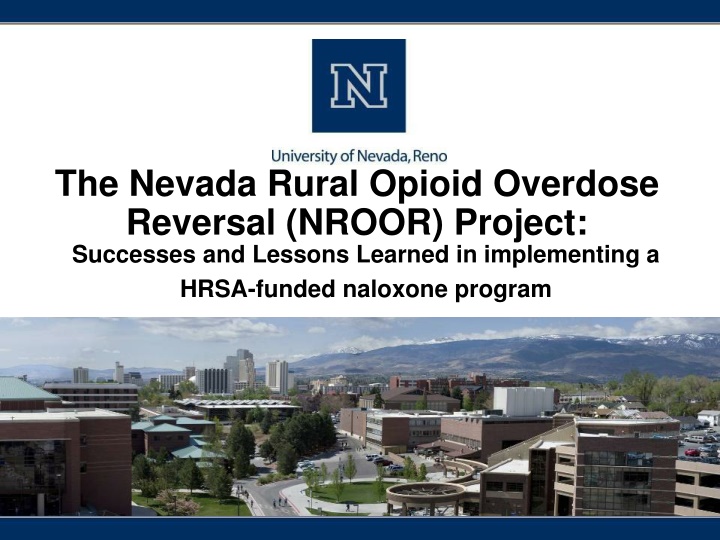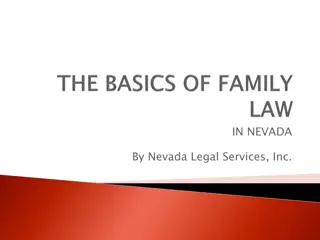Implementing Naloxone Program in Rural Nevada: Successes and Lessons Learned
The Nevada Rural Opioid Overdose Reversal (NROOR) Project focused on purchasing and distributing naloxone, training healthcare professionals, and improving health outcomes in rural areas with opioid overdose incidents. Led by dedicated project personnel and key partnerships, the program aimed to address the opioid crisis through strategic initiatives in rural Nevada counties. Key achievements include purchasing naloxone supplies, training EMS providers, and demonstrating positive impacts on patient care. The project served Esmeralda, Eureka, Lincoln, Lyon, Mineral, Nye, and White Pine counties, highlighting the importance of addressing opioid overdoses in underserved rural communities.
Download Presentation

Please find below an Image/Link to download the presentation.
The content on the website is provided AS IS for your information and personal use only. It may not be sold, licensed, or shared on other websites without obtaining consent from the author.If you encounter any issues during the download, it is possible that the publisher has removed the file from their server.
You are allowed to download the files provided on this website for personal or commercial use, subject to the condition that they are used lawfully. All files are the property of their respective owners.
The content on the website is provided AS IS for your information and personal use only. It may not be sold, licensed, or shared on other websites without obtaining consent from the author.
E N D
Presentation Transcript
The Nevada Rural Opioid Overdose Reversal (NROOR) Project: Successes and Lessons Learned in implementing a HRSA-funded naloxone program
Project Personnel Karla D. Wagner, Ph.D., Associate Professor, NROOR Evaluator karlawagner@unr.edu Christopher E. Marchand, M.P.H., NROOR and Project ECHO Project Director cmarchand@med.unr.edu Evan Klass, M.D., Senior Associate Dean, Office of Statewide Initiatives, NROOR Medical Director Bobbie Sullivan, Education Coordinator, Emergency Medical Systems Funding: HRSA 15-146
Partnership members University of Nevada, Reno Schools of Medicine and Community Health Sciences Nevada Department of Health and Human Services (State EMS Program) Nevada Rural Hospital Partners Desert View Hospital (lead grantee and participating hospital) South Lyon Medical Center (participating hospital) Grover C. Dils Medical Center (participating hospital) Mt. Grant General Hospital
Context Rural areas in the US experiencing dramatic increases in opioid overdose 2015 HRSA Rural Opioid Overdose Reversal RFA to fund: Purchase and placement of opioid overdose devices (i.e., naloxone) in rural communities Training of licensed healthcare professionals and emergency responders Recently passed SB 459 authorized BLS EMS providers (e.g., EMTs) in Nevada to administer naloxone
NROOR Project Aims 1. Purchase naloxone for rural EMTs working in Basic Level Services (BLS) Agencies 2. Train rural EMS providers and other health professionals in overdose recognition and response 3. Provide take-home naloxone for rural patients receiving care for overdose in rural hospitals 4. Demonstrate improved and measurable health outcomes among rural patients being treated by rural EMS and healthcare professionals
Project Service Areas: Esmeralda County Eureka County Lincoln County Lyon County Mineral County Nye County White Pine County
Purchased: 500 prefilled syringes of naloxone & 2,500 IM needles 156 IN NARCAN kits for ED discharge
AIM 2: EMT TRAINING EVALUATION
Methods State EMS delivered training in opioid overdose response and naloxone administration to 117 EMTs in participating agencies Anonymous pre-/post-test surveys collected demographic information, knowledge and attitudes about overdose, naloxone, and SB 459 Evaluation plan included collecting data from state EMS data system on patient outcomes (e.g., time to naloxone administration, patient status, etc.)
Results 117 EMTs trained from February April 2016 Median years served as EMT = 5 (range: 0-35) 85% were volunteer EMTs
Results: Knowledge & Attitudes Significant improvement in overdose knowledge scores, though overall knowledge of overdose symptoms was already high (most >80% correct) Significant improvement in naloxone knowledge scores To be expected, since EMTs were newly authorized to use naloxone via SB459 Significant improvement in self-assessed overdose response competence and reduction in overdose response concerns
Results: SB 459 Knowledge Only 37.6% had heard of SB459 before the training in Spring 2016 Who is allowed to possess naloxone? (% correct) 18 Persons at risk, witnesses, LEOs, EMTs, paramedics * 50 0 Pre 20 40 60 80 100 Post * P <0.05
Results: SB 459 Support % of Respondents Expressing Support for % of Respondents Expressing Support for SB 459 Naloxone Provisions SB 459 Naloxone Provisions Providing limited immunity from prosecution for simple drug possession to anyone who calls 911 in the event of an overdose? 24 31 82 Allowing first responders to administer naloxone in the event of an overdsoe? 89 48 Allowing family members, friends to administer naloxone in the event of an overdose? * 65 0 20 40 60 80 100 Pre Post * P <0.05
AIM 3: PROVIDE TAKE HOME NALOXONE FOR ED DISCHARGE
Take home naloxone for ED discharge Hospitals were hesitant to implement take home naloxone distribution upon ED discharge Two hospitals did some (~12 doses distributed, maybe more) Logistics of standing orders & distribution protocols were challenging Lack of information and/or concerns related to liability protections and other provisions in SB 459
AIM 4: DEMONSTRATE IMPROVED PATIENT OUTCOMES
Results: Patient Outcomes Based on review of available NEMSIS data and calls to participating agencies, only 5 doses of naloxone administered by NROOR EMTs since Spring 2016 Calls to agencies and interviews with EMTs ongoing Data suggest they are not being called to opioid overdose emergencies with the expected frequency
CHALLENGES AND SUCCESSES/LESSONS LEARNED
Successes: Purchased Naloxone Modeled our application on previous grants to buy AEDs for rural communities Though the RFA appeared focused on first responders, we successfully included distribution of take home naloxone for ED discharge Purchased >500 doses of naloxone (most to expire November 2017)
Successes: EMT Training 117 rural EMTs trained over 2-3 week period Successful partnership between UNR and State EMS to deliver and evaluate training Evaluation results Statistically significant improvement in almost all naloxone knowledge questions Opioid overdose competency and concerns scales showed significant improvement Knowledge of and support for naloxone provisions in SB459 increased (though support is not overwhelming) Favorable review by EMTs
Challenges: Funding logistics HRSA RFA required partnership with a rural entity While this was an innovative partnership, administrative and logistical issues slowed implementation Naloxone purchased in bulk and set to expire this fall
Challenges: Lack of SB459 knowledge and hesitance from some prescribers Not on my license Despite liability protections in SB 459, some doctors didn t know about or trust the law, resulting in hesitance to write standing orders and/or facilitate distribution Now in 2017, knowledge about SB 459 among health care providers and prescribers is still low Don t know, don t understand, or don t trust More information and interpretation could reassure providers
Lesson Learned: Need Better Data HRSA proposal was written using statewide hospital billing data, based on ER admissions and opioid overdose deaths Though we established the significance and saw a need, the experience of EMTs in the NROOR service areas does not appear to match Only 5 doses of NROOR naloxone had been administered Data suggest few NROOR EMTs encounter opioid overdose in their regular practice Ongoing surveillance and will help better target resources
Lessons Learned: Need Centralized Coordination NROOR was a one-time, one-year grant, partnership between UNR, EMS, and hospitals Need a plan for sustainability Lack of knowledge among providers still an issue that requires coordinated communication and reassurance Unclear where parties should seek information about statewide opioid overdose response, interpretation of laws, guidance on procedures/protocols for take home naloxone and distribution Centralized coordination would help support sustainable and integrated response
NALOXONE ACCESS EFFORTS
Opportunities for expanded access to naloxone Target population High risk populations (drug users, OD patients, recent detox or incarceration) Strategies Distribution through CBOs, jails, treatment centers, health departments, EDs Pharmacy sales Considerations Prescribers need more info & reassurance about SB459 Prescribers need models for standing orders Cost to purchase at pharmacies Chronic pain patients Co-prescription Pharmacy sales Need to implement risk screening Need co-prescribing protocols Uniformed first responders Equip with naloxone Alleviate liability concerns Need data on who arrives first (targeted deployment) More info about 911 Good Sam Bystanders (friends, family members, others in position to assist) Distribution through CBOs, treatment centers, health departments Pharmacy sales More information about who should carry, how to obtain Cost to purchase at pharmacies
Statewide Naloxone Distribution Update Redistribution of NROOR Naloxone Establishing Community Partners for Distribution Virtual Dispensary
Redistribution of NROOR Naloxone 400 prefilled syringes distributed to rural BLS agencies based on EMS data and hospital ED data Post-project naloxone inventory indicates unreliable data used for distribution plan With only 5 doses of naloxone administered by rural EMTs, it highlights the need for improved data collection and reporting systems Remaining NROOR naloxone will be redistribute to Trac- B Exchange in Las Vegas and Northern Nevada HOPES in Reno to be used before it expires
Establishing Community Partners for Naloxone Distribution Trac-B Exchange Northern Nevada HOPES Clark County Correctional Facility Law Enforcement and Court System Community Paramedicine
Virtual Dispensary Innovative resource that will prevent maldistribution of naloxone Participating organizations will have the appropriate formulary stock of naloxone at all times Naloxone is much less likely to expire without being used Efficient use of resources No need for Nevada to store or ship naloxone, and funds are spent wisely leaving more funding available for other initiatives
Provider Education NROOR focus shifting to academic detailing and other provider education activities (SB 459 & AB 474) Project ECHO Nevada: Expand existing Pain Management ECHO clinic from once per month to twice per month Launched Medication Assisted Treatment (MAT) ECHO clinic September 27th, it will take place twice per month ECHO Nevada infrastructure remains available as a rapid information dissemination resource legislation and regulation updates, public health emergencies, sharing of best practices
Conclusion: Major contributions of NROOR Increased awareness & educational moments Trained 117 EMTs Purchased naloxone Statewide and national visibility Created a model that can be modified based on lessons learned Bulk naloxone purchase set to expire virtual naloxone dispensary center SAMHSA STR building upon and expanding NROOR efforts as appropriate Naloxone access Provider education























